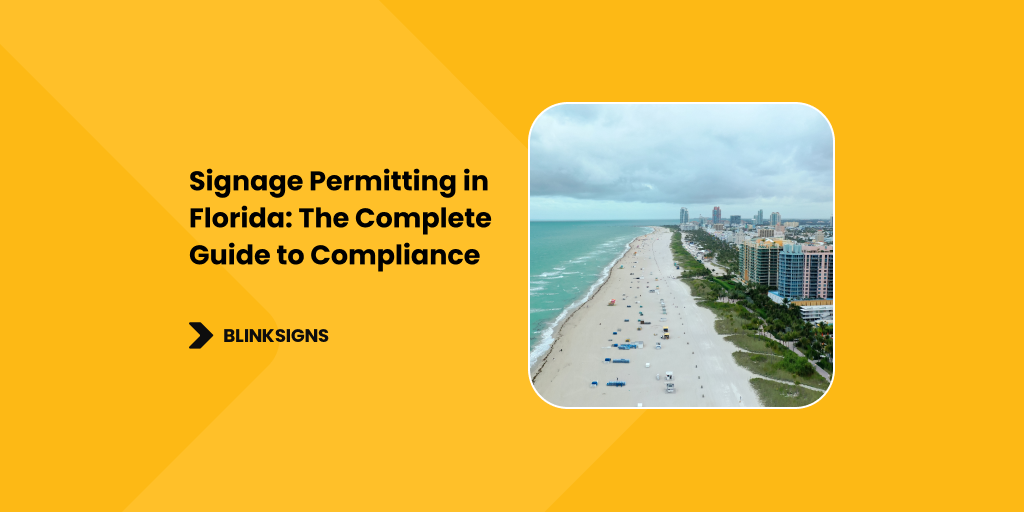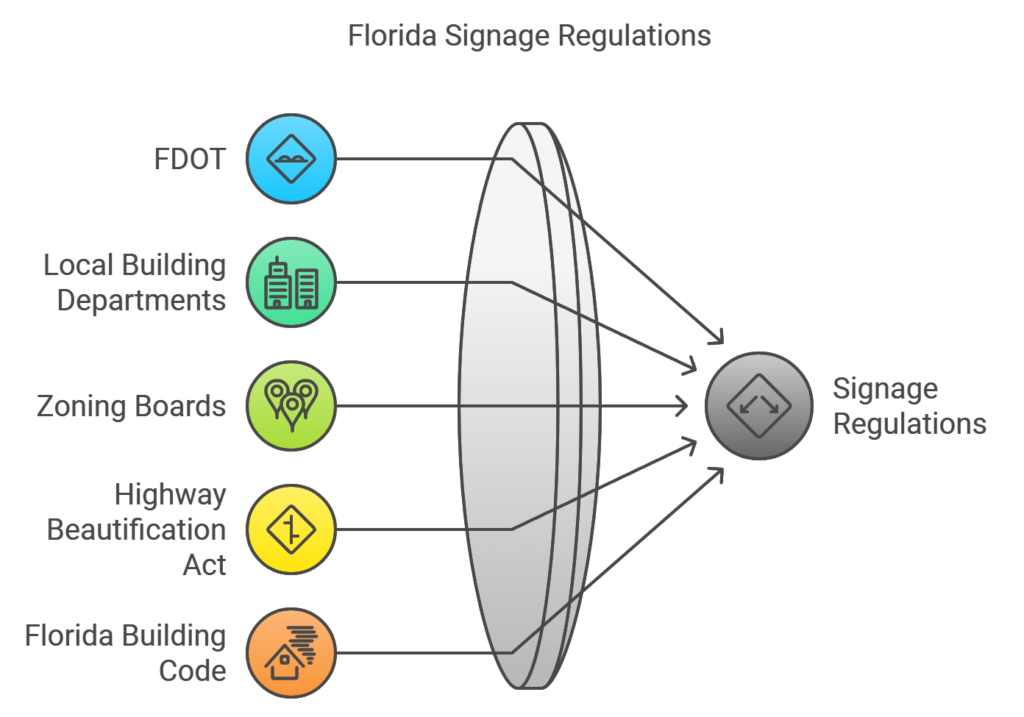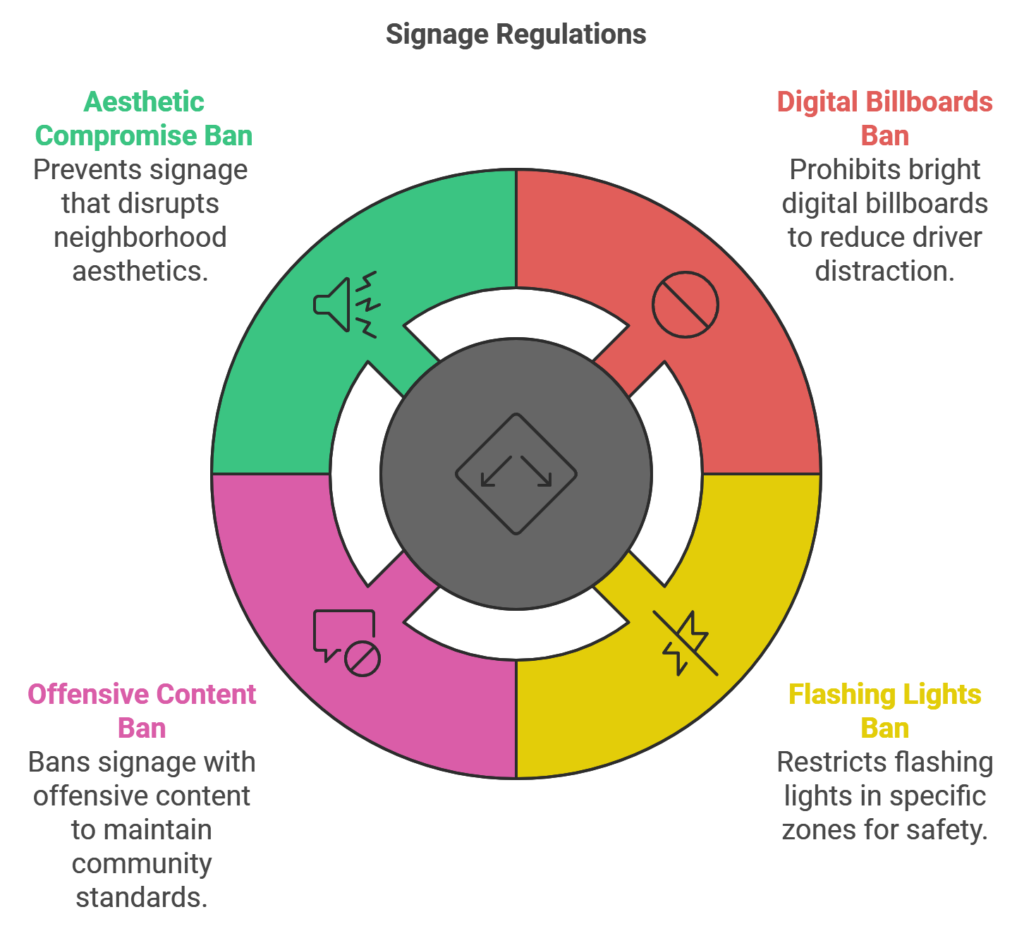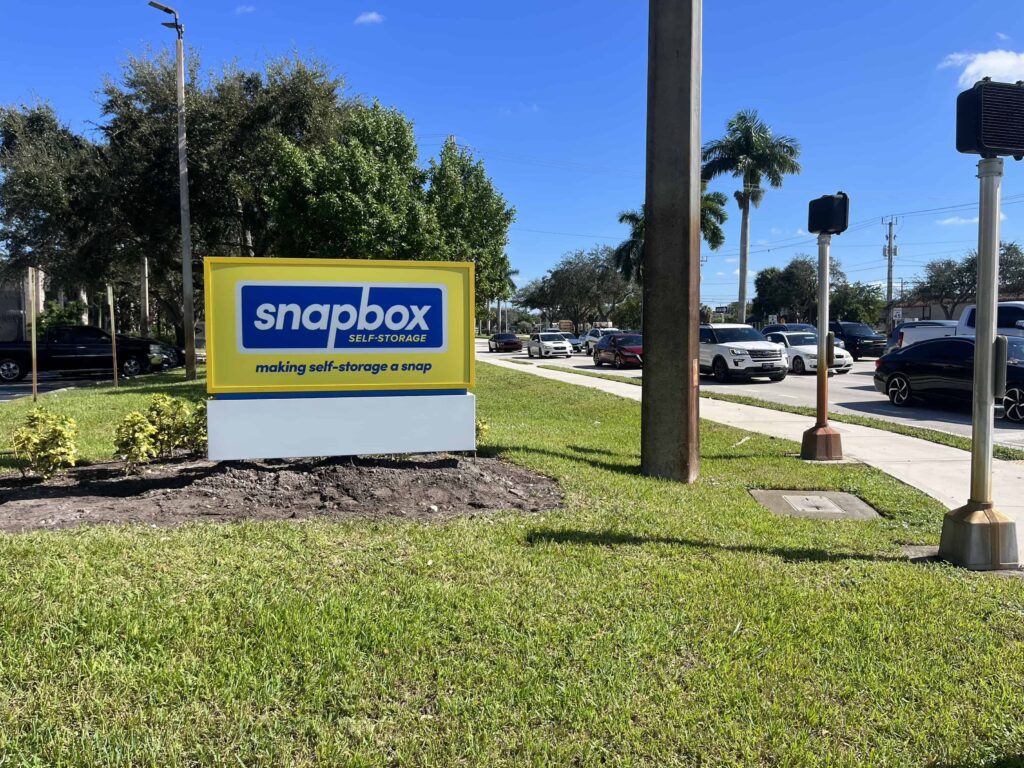
Signage Permitting in Florida: The Complete Guide to Compliance
In Florida’s vibrant business ecosystem, signage is more than just a business marker—it’s a crucial communication tool linking companies to communities. However, creating signage that complies with Florida’s legal standards requires careful navigation through guidelines set by agencies like the Florida Department of Transportation (FDOT), local City Ordinances, and County Regulations. Permitting safeguards public safety and visual harmony, upholding Code Compliance standards that prevent driver distractions, ensure structural soundness, and maintain aesthetic appeal.
Securing a Sign Permit verifies that a business’s signage meets zoning and safety standards, ensuring it’s practical without risking legal issues. At BlinkSigns, we’re skilled at navigating signage permitting in Florida, from urban hotspots to scenic locales, making the process easier so businesses can focus on impactful communication without non-compliance risks.
Understanding the Basics of Sign Permitting in Florida
What is a Sign Permit?
A Sign Permit is a legal requirement often enforced by local Zoning Ordinances and Land Development Codes. It grants businesses permission to install signage that meets specified safety and design standards. These standards cover Sign Area, Height, and Illumination regulations, all meant to protect public safety and enhance local aesthetics.
Key Regulatory Authorities and Statutes
Several entities govern Florida’s signage regulations. FDOT regulates signs along highways, mainly focusing on Right-of-Way areas to keep drivers’ sightlines clear and distraction-free. Local Building Departments and Zoning Boards handle city and county regulations, each with unique standards. Key statutes include the Highway Beautification Act and Florida Building Code, ensuring signage preserves natural and structural integrity. BlinkSigns simplifies working with these entities, ensuring every client’s signage project aligns with municipal codes and Florida’s state requirements.

Florida Signage Regulations
Legal Basis for Sign Regulation
Sign regulations in Florida are rooted in Municipal Codes and State Regulations that prioritize public safety and community character. Compliance with these standards is crucial to avoid penalties, fines, and enforcement actions. With BlinkSigns’ expertise, businesses can rest assured that their signage is legally sound and fully compliant, from initial application to final installation.
Types of Signage and Their Permitting Requirements
Here’s a detailed table to provide clear information on the types of signage commonly used in Florida, their key characteristics, and specific permitting requirements.
| Sign Type | Description | Key Characteristics | Permitting Requirements |
| On-Premise Signs | Signs on the business property are often used to promote the business. | Includes wall signs, monument signs, awning signs, etc. | Regulated by local Zoning Ordinances, typically with specific rules on Sign Area, Height, Setback, and Illumination. Requires application to local building departments with Site Plans and Elevation Drawings. Additional approvals may be needed in Historic Districts or areas with unique aesthetic standards. |
| Off-Premise Signs | Signs that promote products or services are located away from the sign’s physical location, such as billboards. | Typically more prominent and visible from highways or busy roads | Heavily regulated by FDOT along highways, with restrictions on Spacing, Illumination, and Content in certain zones, such as Scenic Highways. Requires approval from FDOT and additional permits from local zoning boards if placed in specific municipal areas. Must adhere to Highway Beautification Act guidelines. |
| Wall Signs | Signs attached directly to the wall of a building are used for business branding or identification. | Mounted on exterior walls, often with lighting | Permitting includes adherence to Building Code standards on Height, Sign Area, and Material. Approval is often needed from local building departments, with additional requirements for Illumination in Residential Zones to reduce light pollution. |
| Monument Signs | Freestanding signs set low to the ground, often placed at entrances for visibility. | Generally no taller than 8-10 feet, often with masonry or sturdy bases | Requires adherence to local zoning codes, with specific Setback and Height requirements. Applications may need Elevation Drawings and structural details, especially for signs near Right-of-Way or Public Property. In Historic Districts, permits may restrict materials and design for aesthetic harmony. |
| Pylon Signs | Tall, freestanding signs supported by one or two poles, often used for visibility from long distances. | Generally over 10 feet in height, highly visible | Requires permits covering Structural Integrity, Wind Load, and Height compliance. Applications must include structural engineering specs, especially in Coastal Zones where wind resistance is essential. Height and setback regulations vary by local zoning requirements. |
| Electronic Message Centers (EMCs) | Digital signs that display changing messages are used for advertising or information. | It often includes LED displays and animations. | Subject to FDOT regulations on Brightness, Animation Frequency, and Message Duration to prevent driver distraction. Permits require electrical plans and compliance with Local Illumination Standards, especially near residential zones. Height restrictions apply based on placement location. |
| Digital Billboards | Large digital displays are primarily used for advertising and are visible on highways and in urban areas. | High illumination and digital screen capabilities | Regulated by FDOT, especially along State Roads and Highways. Permits must cover Spacing from other billboards, Illumination Standards, and Brightness Controls. Applications include FDOT approval if visible from public roads, with potential restrictions on animation and message frequency in scenic zones. |
| Temporary Signs | Non-permanent signs such as banners, real estate signs, or event-specific signs. | Used for short-term promotions, events, or property listings | Temporary permits are generally required, with regulations on Size, Placement, and Duration (usually between 30-90 days). Additional permits may be required if signs are placed in Public Spaces or Right-of-Way areas. Renewals are often needed for extended display periods. |
| Awning Signs | Signs integrated into the fabric canopy of awnings provide business identification or branding. | Typically installed over windows or entrances. | Local zoning boards require permits covering Material compliance, Wind Load resistance, and aesthetic considerations. Signs must adhere to visibility standards without obstructing pedestrian views. Historic areas may impose specific design limitations to maintain architectural style. |
| Canopy Signs | Installed on canopies above entrances or windows, often illuminated, serves decorative and advertising purposes. | Positioned at entryways, often illuminated | Permits cover Electrical Components for illuminated canopies, with additional compliance checks on Visibility and Clearance. Applications may need structural details, especially if installed in areas prone to high winds. Environmental compliance applies in Scenic Zones or Coastal Areas. |
| Window Signs | Signs on windows often display business hours, services, or promotional information. | Frequently used in storefronts, temporary or permanent | Typically requires less stringent permitting but must still comply with Size and Content Restrictions in some cities. Permits may be necessary for illuminated window signs, especially in residential or historic zones. Temporary window signage might need additional short-term permits. |
| Directional and Wayfinding Signs | Signs that assist with navigation are commonly seen in larger commercial complexes, parking lots, or campuses. | Functional, often minimalistic in design | Permitting may require adherence to ADA Compliance Standards for accessibility. Applications include Site Plans showing placement and orientation, ensuring the signage does not obstruct views or disrupt pedestrian flow. Compliance checks for readability and legibility are often enforced. |
| Real Estate Signs | Temporary signs are used for property sales, rentals, or leasing information. | Typically freestanding, smaller than commercial signs | Permits generally require adherence to local Temporary Signage Regulations, covering Size, Height, and Duration (often 30-90 days). Property properties within Residential Zones or Scenic Areas need additional permits to maintain aesthetic consistency. |
Prohibited Signs in Florida
Certain types of signage, such as excessively bright Digital Billboards or flashing lights, are banned to avoid driver distraction, especially in Scenic Highway Zones and near Historic Districts. Restrictions also apply to signs with offensive content or those compromising neighbourhood aesthetics.

Prohibited Signs in Florida
The Florida Sign Permitting Process: Step-by-Step Guide
Application Preparation and Submission
Preparation begins by gathering essential documents such as Site Plans, Elevation Drawings, and Electrical Permits. Complete documentation should detail Sign Area, Clearance, and Wind Load specifications. BlinkSigns helps clients compile thorough and accurate documentation for smooth processing.
Plan Review and Approval Process
Applications are reviewed by the Local Zoning Board or FDOT, depending on location. This Plan Review ensures adherence to zoning and building codes, and larger signs like Pylon Signs or Electronic Message Centers may require extended evaluation. Approval times vary by municipality, and BlinkSigns’ expertise helps avoid delays.
Inspection Requirements and Compliance Checks
After approval, a comprehensive Inspection Process assesses the sign’s structural components, including the Sign Cabinet, Sign Support, and Electrical Components, to ensure compliance with Florida’s Building Code standards. Regular inspections may be required for illuminated or digital signage in high-traffic or public spaces.
Permit Issuance and Installation
Once approved, Permit Issuance authorizes the legal installation of signage in compliance with state and local standards. BlinkSigns oversees every installation to meet Inspection Compliance in Right-of-Way and Private Property zones.
Local Zoning Codes and City-Specific Requirements in Major Florida Cities
Each Florida city maintains distinct signage requirements:
- Miami: Monument and Digital Billboard regulations uphold Aesthetic Standards in historic districts.
- Orlando: Strict Sign Face and Illumination standards apply around tourist centers.
- Tampa: Lighting restrictions limit animation in Residential Zones to reduce light pollution.
- Jacksonville: Signage near natural reserves must follow Environmental Ordinances for Sign Structure and Height.
- Fort Lauderdale: Enforces eco-friendly practices like Dark Sky Ordinances and encourages Sustainable Lighting Standards.
At BlinkSigns, we leverage city-specific knowledge to ensure every installation meets local standards, from visibility regulations to environmental compliance.
ADA and Accessibility Requirements for Signage in Florida
ADA Compliance Standards
Public signage in Florida must meet ADA Standards, ensuring accessible features like Braille, raised text, and appropriate contrast. BlinkSigns’ ADA-compliant solutions enhance accessibility and inclusivity in public spaces across Florida.
Visibility and Readability Standards
ADA mandates require non-glare finishes, regulated character size, and accessible height placements to improve readability for visually impaired individuals. BlinkSigns ensures that all signage meets ADA Compliance requirements, creating accessible environments.
Fees, Costs, and Additional Expenses for Sign Permitting in Florida
Permit Fees Based on Sign Type and Location
Permit fees vary based on sign type and location, ranging from minor fees for Wall Signs to significant costs for complex Digital Billboards. FDOT permits for signs near State Highways also incur additional fees.
Other Potential Costs
Additional expenses may include Inspection Fees, Bond Requirements, and permit renewal costs. BlinkSigns provides a transparent fee structure, helping businesses budget effectively for necessary permits.
Navigating FDOT Regulations for Highway and Scenic Signage
Highway Signage Regulations
FDOT imposes strict guidelines on spacing, Setbacks, and illumination for highway-adjacent signs to protect driver focus. Off-premise signs, such as Digital Billboards and Electronic Message Centers, must meet specific visibility standards to prevent distractions.
Scenic Highway and Byway Signage
In Scenic Highway Zones, FDOT enforces design restrictions to protect Florida’s natural beauty. BlinkSigns ensures that each sign complies with FDOT standards to maintain visual appeal without compromising scenic views.
Variances and Appeals for Signage Permits in Florida
Understanding When a Variance is Necessary
Businesses exceeding standard size, height, or setback limitations may require a Variance. This is common in high-traffic commercial areas where visibility is essential.
Applying for a Variance
Variance applications need supporting documents and justification based on Land Development Codes. BlinkSigns helps streamline this process to increase approval chances.
Appeal Process for Denied Permits
Businesses can appeal with the Board of Adjustment or Zoning and Land Use Departments if a permit is denied. BlinkSigns assists in revising applications and navigating the appeals process for optimal results.
Maintenance and Renewals of Signage Permits in Florida
Ongoing Maintenance Requirements for Florida Signage
Florida requires routine maintenance for compliance with Code Compliance standards. Illumination checks and structural evaluations are critical, particularly for signs in Coastal Zones and Scenic Highway Zones. BlinkSigns assists businesses in meeting inspection standards and protecting signage from weather damage and structural wear.
Permit Renewal Requirements and Processes
Temporary signs often require renewals every few months, while permanent installations may need periodic Inspection Compliance reviews. Renewal applications generally need updated Site Plans and Elevation Drawings to ensure continued compliance.
Environmental and Aesthetic Compliance Standards for Signage in Florida
In Florida, environmental and aesthetic standards are central to the regulation of commercial signage, particularly in sensitive areas such as Scenic Highway Zones, Historic Districts, and Residential Zones. These standards limit the environmental impact of illuminated and digital signage and preserve Florida’s scenic and historic character. Compliance with Environmental Ordinances not only protects Florida’s unique landscapes but also aligns a business with community values, enhancing brand reputation.
Light Pollution Regulations
Florida imposes strict Light Pollution Regulations that dictate illuminated signage’s brightness, placement, and orientation. The aim is to minimize unwanted light spillover in areas where artificial light could disrupt local ecosystems or affect residents. Signage must be carefully positioned in residential zones and environmentally sensitive areas to reduce the risk of light trespassing into nearby homes or natural habitats. These zones often require signs to be oriented away from residential properties and wildlife areas to mitigate nighttime brightness and preserve the natural dark skies.
Municipalities such as Fort Lauderdale and St. Augustine are especially stringent in enforcing these regulations, with clear LED and Neon signage restrictions. Business owners in these areas must carefully calibrate the Lighting Levels of their signs to comply with Dark Sky Ordinances, which are enforced to protect nocturnal wildlife and maintain nighttime visibility for drivers. By adhering to these standards, BlinkSigns ensures that illuminated signage remains impactful without negatively impacting the surrounding environment, creating an atmosphere that aligns with both business goals and community expectations.
Eco-Friendly Practices and Materials
The push toward sustainable signage in Florida has made Eco-Friendly Practices a priority for businesses nationwide. This includes using Sustainable Lighting Standards, Recyclable Materials, and energy-efficient options like LED lighting that consume less power and reduce carbon footprints. Using eco-friendly materials is not only a proactive step toward reducing environmental impact but also a reflection of a business’s commitment to responsible practices, which can resonate positively with eco-conscious customers.
Eco-friendly signage is especially recommended in Coastal Zones, where saltwater exposure can degrade certain materials faster, potentially leading to more frequent replacements and higher environmental impact. BlinkSigns offers a range of sustainable options tailored for durability in Florida’s unique climates, from the inland areas to coastal regions. These solutions include weather-resistant, recyclable materials that withstand intense sunlight, high humidity, and saline environments. Additionally, sustainable signage requires less maintenance, reducing long-term costs and ensuring that businesses meet Environmental Protection standards in alignment with local regulations.
Taxes and Financial Considerations for Signage in Florida
Local tax regulations and other financial considerations influence signage-related expenses in Florida, particularly for large signs such as Billboards and Freestanding Signs. These financial implications can significantly impact a business’s budget planning, especially given the extensive permit fees, maintenance costs, and tax requirements associated with permanent signage structures.
Tax Implications for Billboards and Large Signs
In Florida, billboards and substantial signs are treated as real property improvements and are subject to property tax assessments by county building departments. These taxes are calculated based on several factors, including Sign Area, location, and whether the sign is illuminated. For instance, billboards on State Roads under FDOT jurisdiction typically incur higher tax liabilities due to their prime visibility along major traffic routes.
Proper financial planning ensures these tax obligations do not disrupt business operations. BlinkSigns assists businesses in understanding the tax landscape associated with different signage types, helping to account for these taxes in their budget forecasts. Property tax assessments can be particularly impactful for large billboards and digital displays, with implications that vary widely by county. By staying informed on tax requirements, businesses can make strategic decisions that maximize visibility without unexpectedly inflating expenses.
Deductible Expenses and Investment Strategies
Many signage-related expenses, including Permit Fees, Renewal Costs, and Maintenance Costs, are tax-deductible, providing businesses with financial relief and making signage investments more manageable. Deducting these expenses can result in significant savings, allowing businesses to reinvest in maintaining compliance or expanding their marketing reach. Additionally, strategic investment in durable, low-maintenance signage can reduce overall costs by minimizing the need for frequent repairs or replacements.
BlinkSigns guides clients in leveraging these deductible expenses to improve cost efficiency, helping them allocate resources effectively while maintaining full compliance with state and local codes. By understanding and optimizing these tax benefits, businesses can not only enhance their advertising reach but also realize substantial savings that support other operational needs. This strategic approach to signage investment aligns with BlinkSigns’ commitment to helping clients achieve compliance and financial efficiency in their advertising.
Key Considerations for Business Signage in Historic and Coastal Areas
Florida’s Historic Districts and Coastal Zones have additional regulations to preserve these unique environments’ cultural heritage and natural beauty. Compliance with these regulations is critical for businesses operating in these areas to avoid fines and protect local aesthetics and community character. Ensuring compatibility with local standards in these regions is particularly challenging due to design elements, size, and materials restrictions.
Historic District Requirements
Historic districts, such as those in St. Augustine, Key West, and other Florida cities with rich cultural backgrounds, maintain rigorous standards to protect architectural heritage. In these zones, signage must blend seamlessly with historical aesthetics, often prohibiting modern design elements like vibrant colours, large Electronic Message Centers (EMCs), or animated displays. Signs in historic districts are typically required to resemble Monument Signs, Wall Signs, or other traditional formats that reflect a subdued colour scheme and classical architectural style.
Non-compliance with historic district regulations can lead to removal orders, fines, or mandated redesigns to meet community standards. BlinkSigns’ expertise in historic signage allows businesses to create compliant, visually appealing signs that capture the unique character of Florida’s historic areas. BlinkSigns enables businesses to align with preservation standards while ensuring optimal visibility by offering custom signage solutions tailored to these specific requirements.
Coastal Zone Sign Regulations
Florida’s Coastal Zones are subject to stringent Environmental Protection standards due to their susceptibility to erosion, weather impacts, and environmental sensitivity. In these areas, signage must be built with materials and structural supports to endure high wind speeds, saltwater exposure, and the intense Florida sun. Signage in these zones must also meet strict Wind Load requirements, ensuring durability against coastal storms and hurricane-force winds.
For businesses near popular coastal areas, such as Miami Beach or Naples, BlinkSigns offers specialized solutions that meet regulatory standards and environmental durability. We provide weather-resistant materials that can withstand harsh coastal conditions while adhering to FDOT Right-of-Way Division regulations. By prioritizing environmentally sensitive practices, businesses can effectively advertise in coastal zones without compromising the area’s natural aesthetics or environmental integrity.
Commonly Asked Questions About Signage Permitting in Florida
For businesses navigating Florida’s signage regulations, common questions arise regarding permitting requirements, compliance standards, and penalties for non-compliance. Here are answers to some frequently asked questions to help clarify the process:
- Do I need a permit for temporary signs in Florida?
Yes, most temporary signs require a permit, especially in high-traffic areas, commercial zones, and scenic locations. These permits help maintain visual harmony and reduce clutter. - What are the penalties for non-compliance with FDOT regulations?
Non-compliance with FDOT guidelines can result in fines, removal orders, and potential operational delays, especially for signs near state roads or highways. - Can I install illuminated signage near residential zones?
Florida restricts illuminated signage in residential areas, enforcing limits on brightness, orientation, and placement to prevent light pollution and protect residents. - Are there specific rules for signage in Florida’s tourist areas?
Tourist zones, such as those in Orlando and Miami Beach, enforce additional restrictions to ensure that signage aligns with aesthetic standards and minimizes distractions. - What are the height restrictions for billboards along Florida highways?
Height restrictions vary by highway type, but signs are generally kept low to avoid obstructing views and maintain visual consistency along scenic routes. - Do I need special insurance for large or illuminated signs?
Some municipalities require additional insurance or bonds for substantial signs, particularly those installed in public areas or along highways. - How does FDOT enforce signage regulations?
FDOT regularly inspects signs near highways and scenic routes, imposing penalties or removal orders for those not meeting state standards.
BlinkSigns provides expert guidance on these concerns, ensuring businesses can confidently navigate Florida’s permitting landscape with full awareness of compliance requirements and potential challenges.
Resources and Tools for Florida Signage Permitting
To streamline the signage permitting process in Florida, BlinkSigns offers various resources and tools, including direct access to key regulatory websites, permit checklists, and application templates. These resources are designed to help businesses prepare complete and accurate applications, ensuring compliance from the start.
Important Links and Contact Information
Access to FDOT resources, local municipal websites, and zoning boards helps business owners stay informed on region-specific regulations. BlinkSigns also provides direct contacts for building departments and zoning authorities in cities such as Orlando, Tampa, and Miami, simplifying communication and reducing delays in the permitting process.
Permitting Checklists and Templates
Our downloadable checklists and templates make it easy to organize necessary documentation, such as Site Plans, Elevation Drawings, and Electrical Permits. These resources guide businesses through gathering accurate information, ensuring no details are overlooked during the application process.
Professional Sign Permitting Services

Snapbox Self Storage signage
With BlinkSigns’ full-service approach to signage permitting, businesses gain a partner dedicated to achieving timely approvals and compliance. Our team manages everything from initial application preparation to compliance checks, addressing each municipality’s unique requirements. If any applications face unforeseen challenges, BlinkSigns also assists with appeals and variance requests, making the process as smooth and stress-free as possible.
Conclusion
Navigating Florida’s signage permitting process can be complex, but with BlinkSigns as your partner, you can trust that every aspect will be handled efficiently and expertly. From application submission and code compliance to ADA accessibility and environmental standards, BlinkSigns brings local knowledge and regulatory expertise to every project.
Whether your business is in bustling Orlando or on the scenic coastline of Fort Lauderdale, BlinkSigns is equipped to ensure your signage is compliant and impactful. Our commitment to regulatory adherence and customer success is unmatched, enabling your business to communicate effectively and attractively within Florida’s unique landscape. Contact BlinkSigns today at Sales@blinksigns.com to bring your vision to life, ensuring it shines brightly and legally across the Sunshine State.